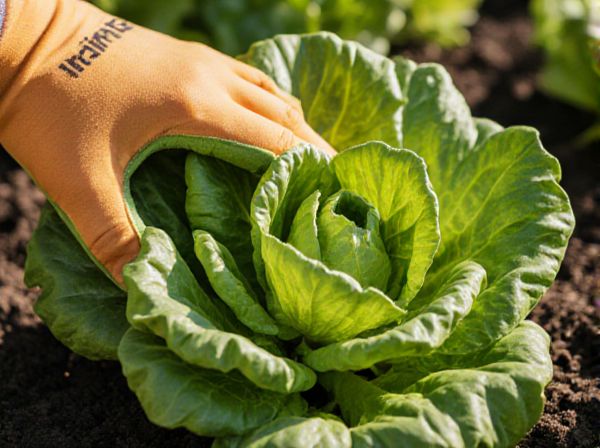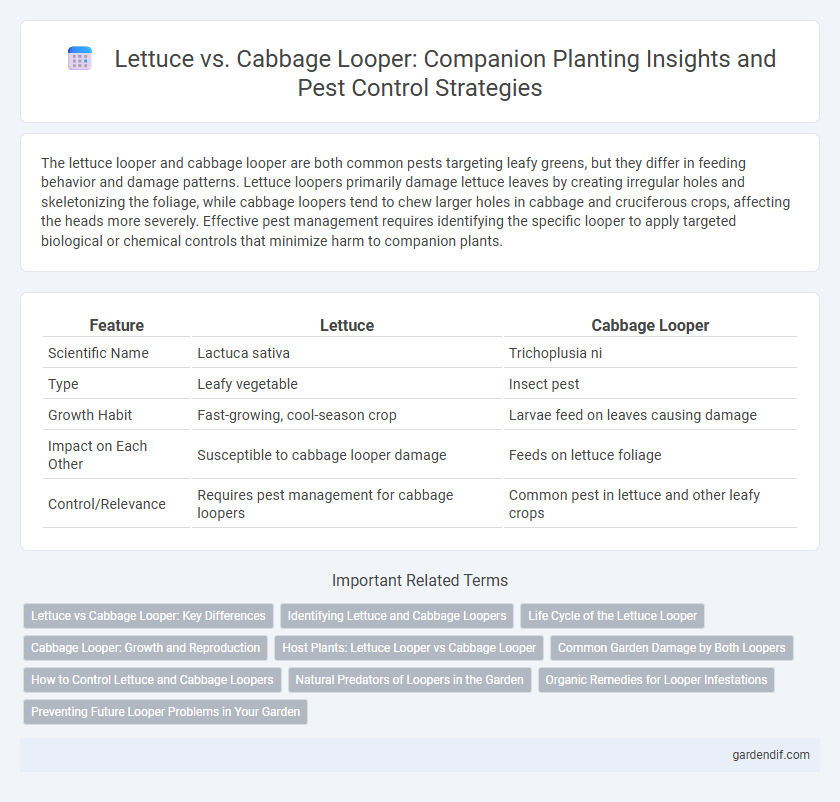
Lettuce vs cabbage looper Illustration
The lettuce looper and cabbage looper are both common pests targeting leafy greens, but they differ in feeding behavior and damage patterns. Lettuce loopers primarily damage lettuce leaves by creating irregular holes and skeletonizing the foliage, while cabbage loopers tend to chew larger holes in cabbage and cruciferous crops, affecting the heads more severely. Effective pest management requires identifying the specific looper to apply targeted biological or chemical controls that minimize harm to companion plants.
Table of Comparison
| Feature | Lettuce | Cabbage Looper |
|---|---|---|
| Scientific Name | Lactuca sativa | Trichoplusia ni |
| Type | Leafy vegetable | Insect pest |
| Growth Habit | Fast-growing, cool-season crop | Larvae feed on leaves causing damage |
| Impact on Each Other | Susceptible to cabbage looper damage | Feeds on lettuce foliage |
| Control/Relevance | Requires pest management for cabbage loopers | Common pest in lettuce and other leafy crops |
Lettuce vs Cabbage Looper: Key Differences
Lettuce is a leafy green vegetable highly susceptible to damage from the cabbage looper, a moth larva that feeds on its leaves, causing significant crop loss. The cabbage looper (Trichoplusia ni) differs from other pests by its distinctive inchworm-like movement and preference for cruciferous plants, yet it also targets lettuce due to its tender foliage. Effective pest management in lettuce cultivation requires understanding these differences to implement targeted biological controls and minimize damage.
Identifying Lettuce and Cabbage Loopers
Lettuce loopers (Trichoplusia ni) are pale green caterpillars with distinctive white or yellowish stripes running longitudinally along their bodies, commonly found on lettuce leaves causing irregular holes. Cabbage loopers (also Trichoplusia ni) appear similar but tend to be more robust and exhibit looping movement when disturbed, primarily targeting cabbage and other cruciferous plants. Accurate identification hinges on observing body color, movement patterns, and specific host plants to implement effective pest management strategies.
Life Cycle of the Lettuce Looper
The lettuce looper (Trichoplusia ni) undergoes a complete metamorphosis, progressing through egg, larva, pupa, and adult stages within approximately 30 days under optimal conditions. Larvae are the primary damaging stage, feeding voraciously on the leaves of lettuce and other crops, causing significant defoliation. Understanding this life cycle is crucial for timing companion planting strategies and targeted pest management to minimize crop damage from lettuce loopers compared to cabbage loopers.
Cabbage Looper: Growth and Reproduction
Cabbage loopers (Trichoplusia ni) undergo rapid growth through four to five larval instars, with each stage lasting approximately 4 to 7 days depending on temperature and food availability. Females lay up to 300 eggs on the undersides of host leaves, primarily targeting members of the Brassicaceae family, which supports rapid population expansion. Effective management of cabbage loopers is critical due to their high reproductive potential and their ability to cause significant damage to crops such as cabbage, broccoli, and lettuce.
Host Plants: Lettuce Looper vs Cabbage Looper
Lettuce looper (Trichoplusia ni) primarily targets leafy vegetables such as lettuce, spinach, and other greens, causing significant damage to these tender host plants by feeding on their foliage. Cabbage looper (also Trichoplusia ni), often confused with the lettuce looper, prefers cruciferous plants such as cabbage, broccoli, and cauliflower but can also infest lettuce in mixed crop environments. Understanding the specific host preferences of lettuce looper and cabbage looper is crucial for effective pest management in vegetable crops.
Common Garden Damage by Both Loopers
Lettuce and cabbage loopers cause significant damage in gardens by primarily feeding on the foliage, creating irregular holes and skeletonizing leaves. Both pests reduce photosynthetic capacity, leading to stunted growth and lower crop yields in crops such as lettuce, cabbage, and related brassicas. Early detection and integrated pest management strategies help mitigate common garden damage caused by these voracious loopers.
How to Control Lettuce and Cabbage Loopers
Controlling lettuce and cabbage loopers involves regular monitoring and the use of organic insecticides such as Bacillus thuringiensis (Bt), which effectively targets larvae while preserving beneficial insects. Introducing natural predators like Trichogramma wasps and maintaining healthy crop diversity can disrupt looper life cycles and reduce infestations. Proper sanitation, including removing plant debris and weeds, also limits breeding sites and helps manage looper populations in companion planting systems.
Natural Predators of Loopers in the Garden
Lettuce plants attract natural predators like parasitic wasps and ladybird beetles that effectively control cabbage looper populations. Birds such as sparrows and predatory insects including lacewings also prey on loopers, reducing their damage to garden crops. Encouraging these beneficial predators in the garden ecosystem helps maintain healthy lettuce growth without chemical pesticides.
Organic Remedies for Looper Infestations
Organic remedies for controlling lettuce and cabbage looper infestations include the use of Bacillus thuringiensis (Bt), a natural soil bacterium that targets looper larvae without harming beneficial insects. Neem oil acts as an effective repellent and disrupts the growth cycle of the cabbage looper, while insecticidal soaps can physically remove larvae from leaves. Encouraging natural predators such as parasitic wasps and lacewings provides sustainable biological control and reduces the need for chemical interventions.
Preventing Future Looper Problems in Your Garden
Companion planting with natural predators like parasitic wasps or introducing plants such as dill and cilantro can effectively deter cabbage looper infestations on lettuce. Maintaining healthy soil and removing damaged leaves promptly reduces the likelihood of loopers laying eggs, ensuring stronger plant resilience. Using row covers during peak looper activity periods provides a physical barrier to prevent larvae from reaching your lettuce, minimizing future garden problems.
Lettuce vs cabbage looper Infographic

 gardendif.com
gardendif.com